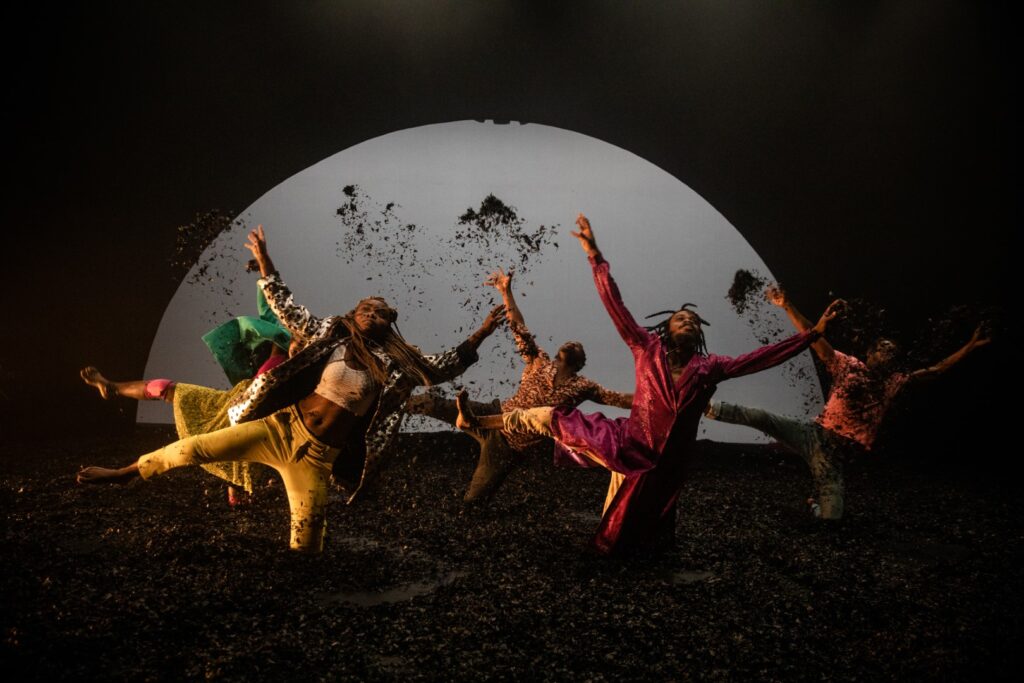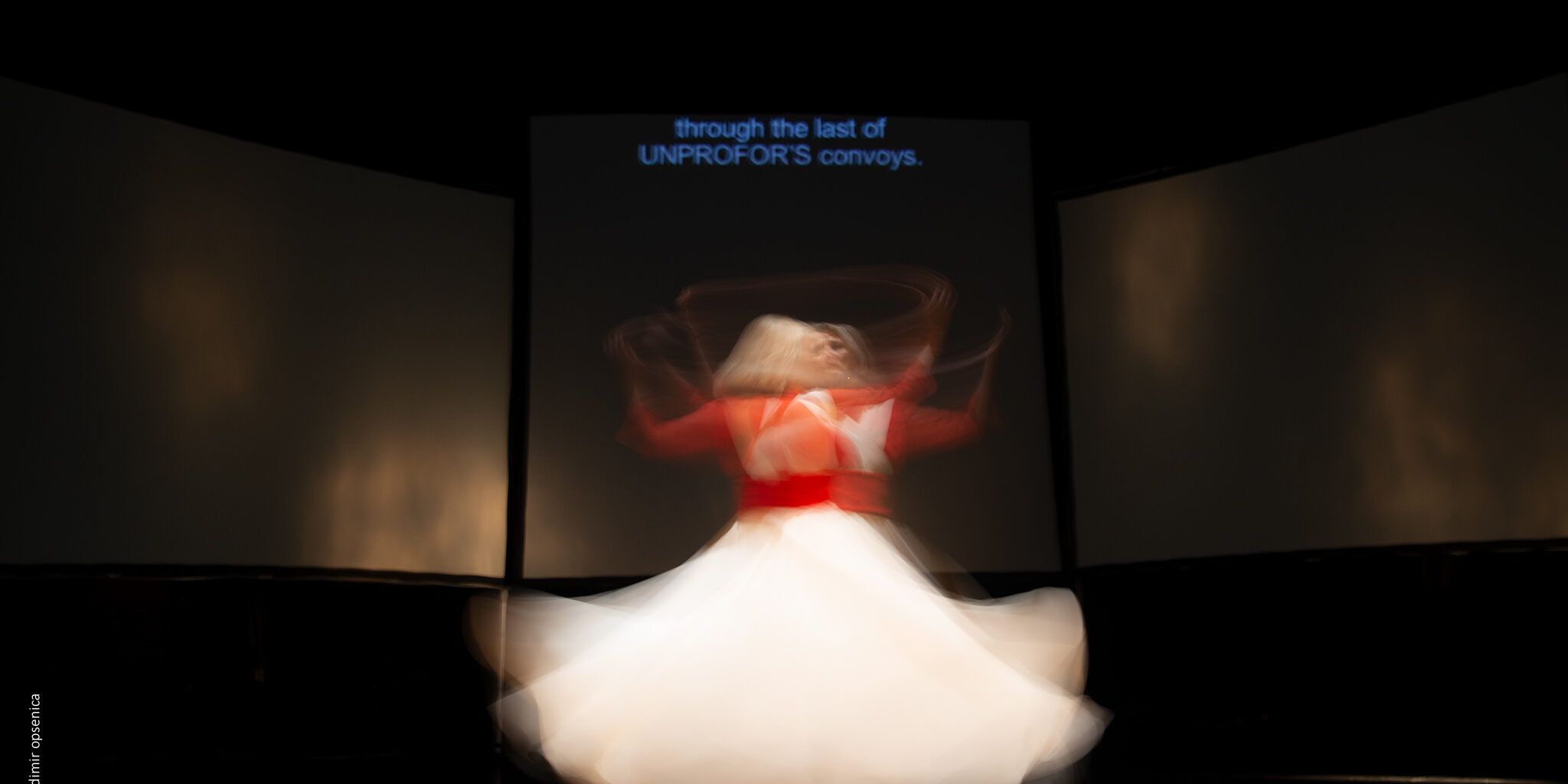Station Service for Contemporary Dance/Faso Danse Théâtre (Presented as part 57th BITEF)
There were two dance performances on the main programme of the 57th BITEF this year, one from Serbia, the other an international co-production from Belgium and Burkina Faso.
The first bore the long title Desire to make a solid history will end up in failure was a dance piece about dance, while the second, Wakatt, as a dance piece fused with a jazz concert. The first piece explores the socio-political context on the independent dance scene in Serbia, while the second articulates the socio-political ruin of the contemporary world through dance. Both note the emergence of societal decay, with the first piece optimistically emphasising the perseverance of the human spirit, while the second pessimistically warns of man’s destructive nature.
Desire to make a solid history will end up in failure is the authorial project of Serbian choreographer Igor Koruga, who has been working with art theorist Milica Ivić since 2015 on a regional project to archive contemporary dance organised by Nomad Dance Academy. His performance, produced by Station Service for Contemporary Dance from Belgrade, was created as an attempt to answer the question: in what way can archiving dance art be an artistic practise?
Director and choreographer Koruga and dramaturg Ivić interviewed six veterans of the Serbian independent dance scene and, with them as performers, created a collage of fragments from their long and rich careers, while also re-examining their influence, their role and their importance in the Serbian art scene, as well as the historical context in which they operated.
The result of this primarily investigative work is a kind of sentimental criticism of the past. In the beginning, the show suggests that the independent dance scene in Serbia emerged as an expression of discontinuity with traditional art forms. The appearance of the dancers on stage interrupts the calm baroque piano music. Their appearance triggers an unsettling noise and murmur. Then you hear the statement that they have all performed in important productions and they question whether that makes them stars. The decisive answer follows immediately: no.
Their performance practise was perceived as a foreign body on Serbian stages, and since their existence depended largely on foreign funding, they were also labelled as traitors to the country.
The piece has an intermittent structure, alternating collective and individual performances, including Nela Antonović, Jelena Jović, Sanja Krsmanović Tasić, Tatjana Pajović, Anđelija Todorović and Boris Čakširan. The collective parts, in addition to the joint dance performances, were organised as the performers’ answers to the questions posed by the author. Through an extensive questionnaire we learn that they have performed in many venues, which artists they have collaborated with, which institutions they have worked in, how long they have been on stage, whether they like Pina Bausch, which protests they have participated in and which ones they have not, and so on. This questioning demonstrates that these six by no means reflect a homogeneous artistic unity, but represent different, sometimes completely contradictory attitudes and ideas, and that their work in one context has produced different experiences.
The individual scenes represent the reconstruction of individual achievements. For example, Nela Antonović re-performs the dance created for the 1979 film “Ćele kula”. This is done in parallel with the screening of the film itself, so that the dual perspective of the younger and older Nela achieves the effect of the passage of time, the persistence of the human spirit and the erosion of the human body, sentimentality and transience. performing arts. Also worth mentioning is Sanja Krsmanović Tasić, who spins on her own axis while an audio montage of her confession about surviving the country’s transitional period and feeling betrayed by neoliberal capitalism can be heard. Boris Čakširan talks about the challenges queer people faced in Yugoslavia and how the first drag show he saw was not an artistic phenomenon but a sociological one. His story is a testament to how queer people’s quality of life suffered and how art was both a refuge and a means to improve society.
Koruga has created an impressive, educational, experimental and interesting performance, though one that contains some omissions. The focus is mainly on the performers themselves and their experiences during the turbulent period, while references to contemporary dance itself, its understanding, function and characteristics have been largely neglected. The mere fact that some movements and choreography are revived can be interpreted as an introduction to contemporary dance, but the audience, knowing little or nothing about it, is deprived of the true understanding of the central factor of this performance.

Wakatt de Serge Aime Coulibaly au Theatre National Wallonie Bruxelles.
Wakatt by Serge Aime Coulibaly at the Theatre National Wallonie Bruxelles.
Although Desire to make a solid history will end up in failure is filled with stories about turbulent historical circumstances in Serbia, it’s full of strong characters from the independent dance scene and ends with a call to support artists to create a better community. This is in stark contrast to Wakatt; conceived and choreographed by Serge Aimé Coulibaly, this piece generated a very pessimistic atmosphere. While Koruga’s show is full of references to concrete spaces, events and people, Wakatt is conceived as an abstract, universal saga about “our age”, which is what the word of the title means in Mooré, the main language of Burkina Faso.
The scenography consists of three symbolic motifs. A large, white, semi-circular disc that can be interpreted as dawn and dusk, but in any case, as the time of the reign of shadows. The stage is covered with a thick black matter, reminiscent of ash, dirt and desolation. On the side is a large mountain of gold, which suggests the conflict for material wealth. In this world of shadows, desolation, greed and violence, the dead rise with nylon bags on their heads, there are riots, jostling that regularly escalate into choreographed conflicts, domination over gold is won and lost, rich people appear in fur coats accompanied by fighters in militant masks crawling like obedient dogs ready to kill, the unprotected help each other but soon perish. But all of this happens without any particular order or causality.
This diabolical anguish is accompanied by Magic Malik’s jazz music in a tense tempo and often disturbing melody. The music is integral and best part of the production. Magic Malik creates an intricate tapestry of harmonic dissonance that unfolds as a poetic metamorphosis of various musical elements. The rhythmic complexity of Malik’s compositions is emblematic of a postcolonial soundscape in which different cultural rhythms converge and collide. In his exploration of sound, Magic Malik takes on the role of an alchemist, transforming traditional jazz into something entirely new.
The flute, his instrument of choice, accompanied by Maxime Zampieri (drums) and Jean-Luc Lehr (bass), is more than just a vessel for melodies. Magic Malik’s music reflects the broader socio-cultural context in which it is created and serves as a mirror to the tensions, changes and anxieties of our time. It is a manifestation of the inherent conflict between repetition and noise, and reveals the complicated relationship between music, power and society. Magic Malik also uses his voice as an instrument to break through the conventional boundaries between vocalisation and instrumentation.
The choreography is consistent in what feels like the same movements repeated over and over again. The performers roll on the black fabric and throw it around. They punch and push each other. The movements are sharp and aggressive. The whole thing is accompanied by occasional screaming, swearing and yelling that we’re all going to die. The choreography represents the struggle between subjugation and liberation, torture and salvation, attack and escape, demonstration of force and suffering of the powerless.
But ultimately the piece feels like an over-the-top attempt to portray the modern world as a horrible place. The accumulation and repetition of scenes of general evil has no strong effect. The scenes start to feel painfully monotonous until the finale, where a performer steps on stage wearing a bomb jacket that he activates.
Everything is constructed in such a way that we are told unequivocally that we are living in horror, but without ever referring to a specific context. The lack of any concreteness at times makes Wakatt feel superficial. However, it is also the case that Wakatt is the only production in the BITEF programme that is partly non-European. This has been a pattern for some years at BITEF, with the programme including a single piece from outside Europe.
Whereas one dance performance felt successful because it dealt with a specific cultural context in an interesting way, to an audience who were in part at least familiar with this context, the main shortcoming of the other, for me, was that it’s context felt poorly defined. However, maybe I missed something in Wakatt that I am not aware of or familiar with. It can be a problematic when a critic is making a judgement about work made in a different cultural context or about something they don’t know enough about. On the other hand, it can also show how an artistic sign system can work well in the context in which it was created, while it is met with misunderstanding elsewhere. This is at least in part a consequence of having one non-European guest performance in isolation on the programme.
Further reading: 57th BITEF: Sun, song and strength – a critical dialogue
Andrej Čanji is a theatre critic and theatrologist based in Belgrade.








